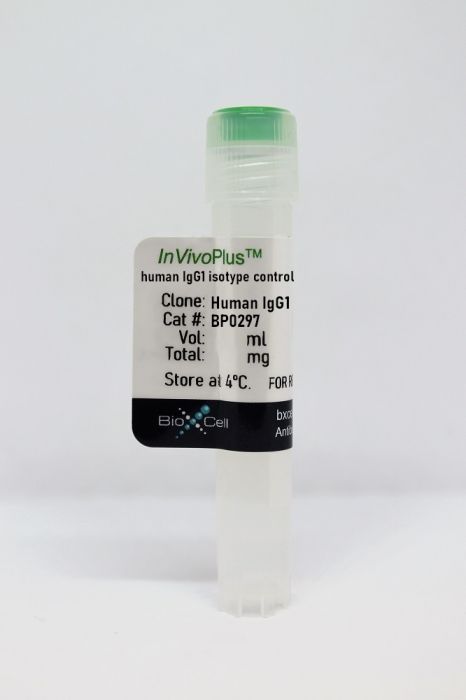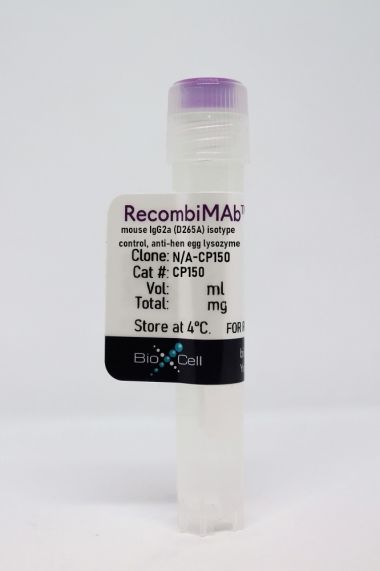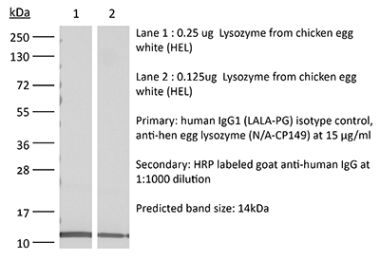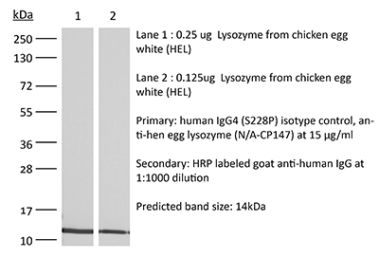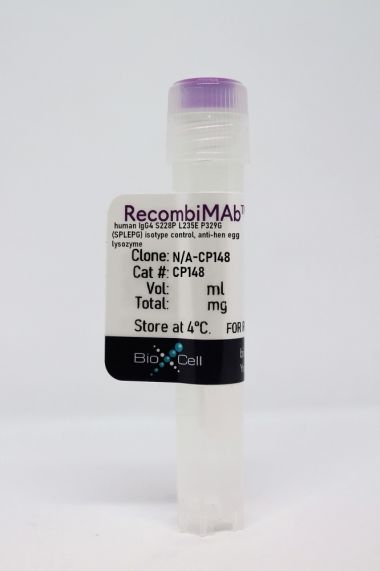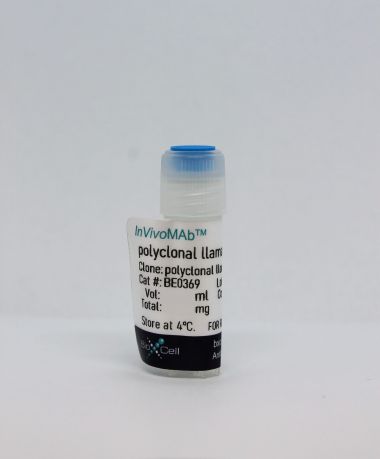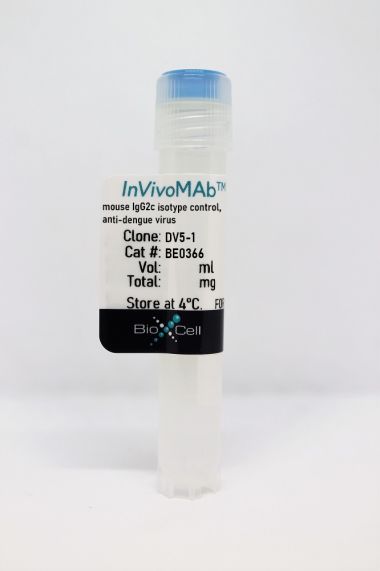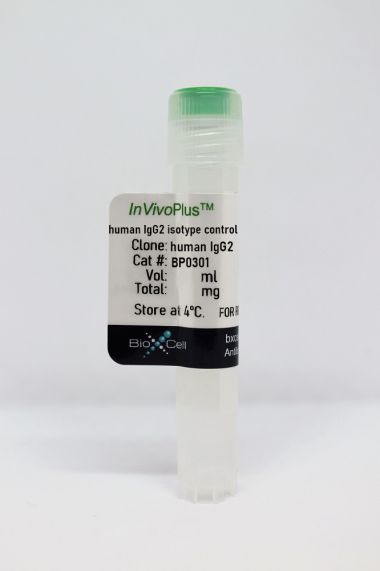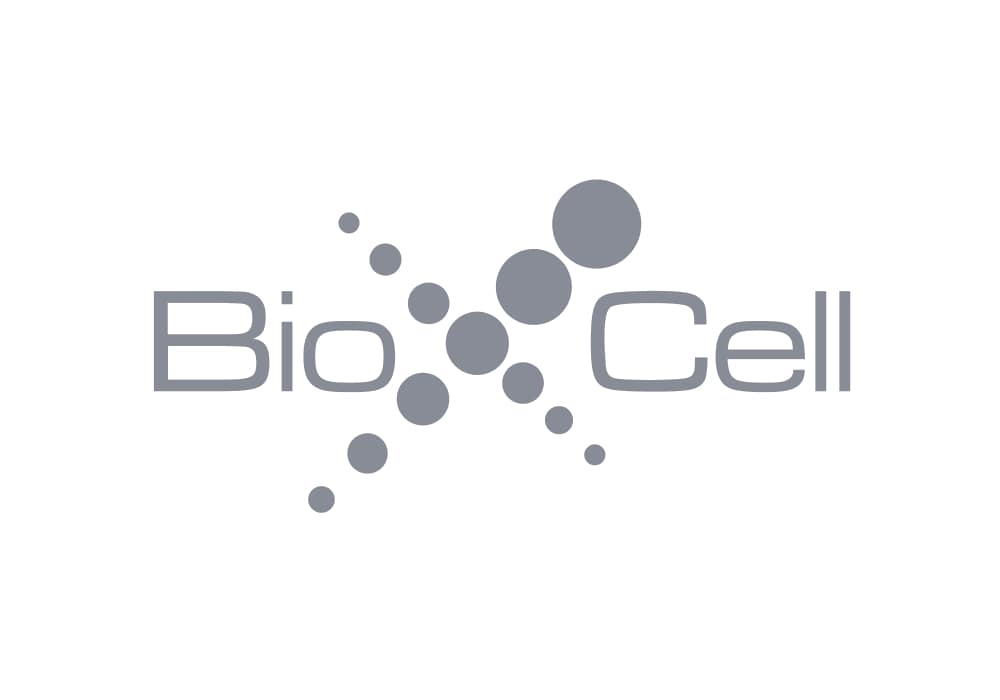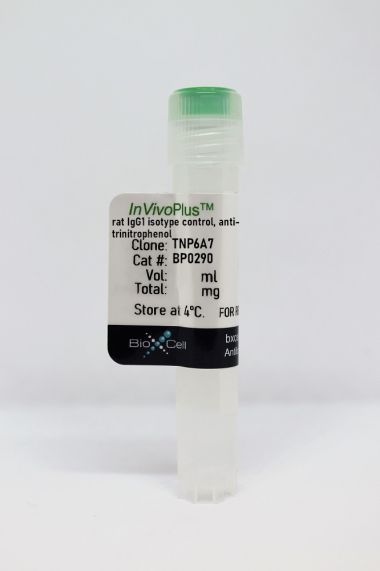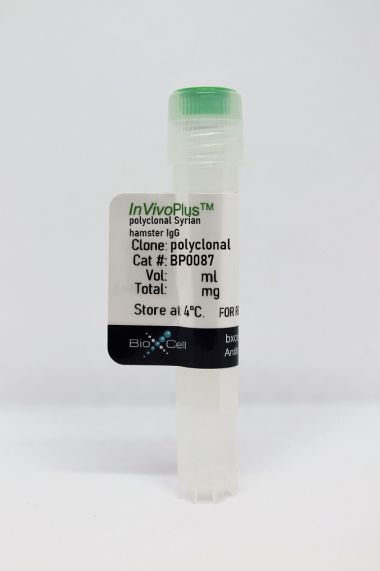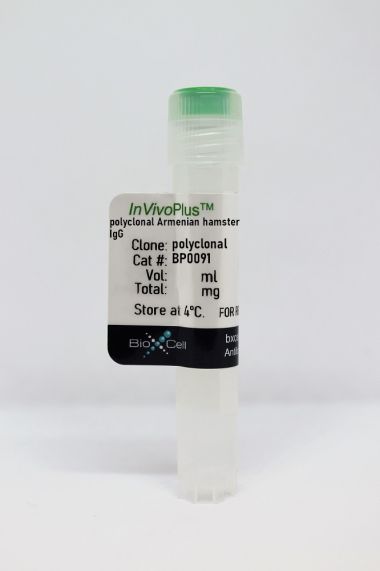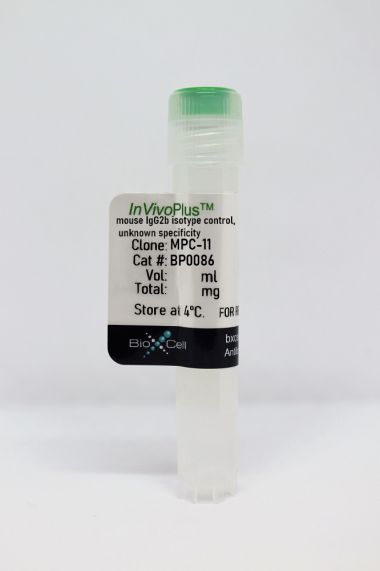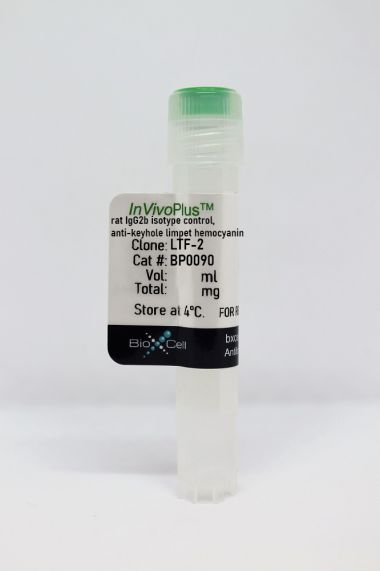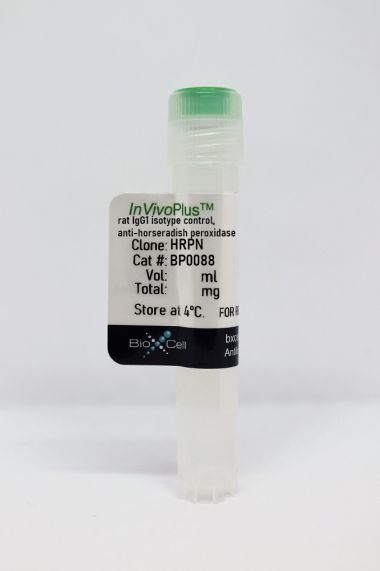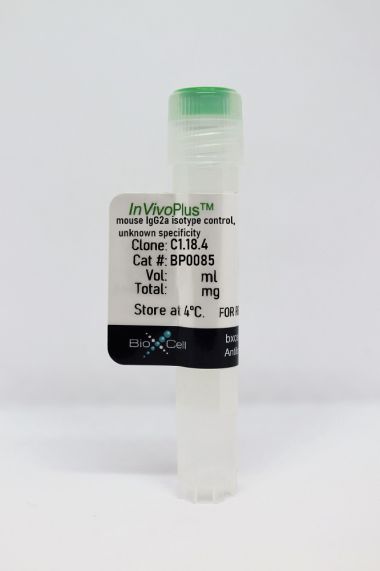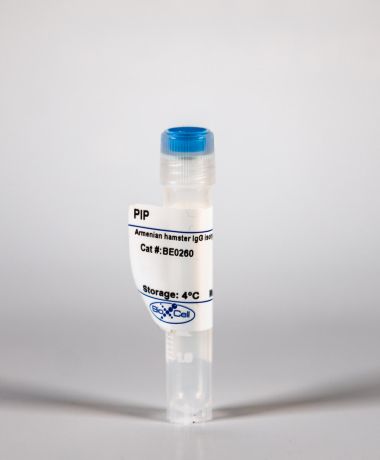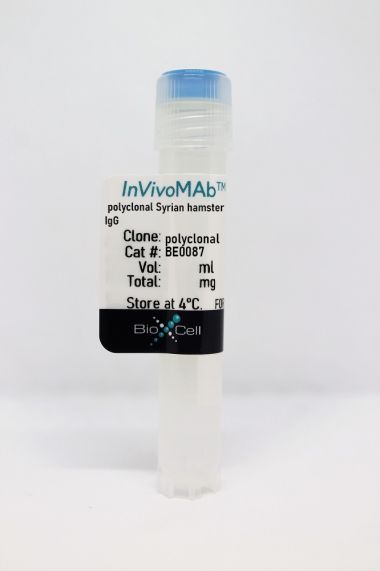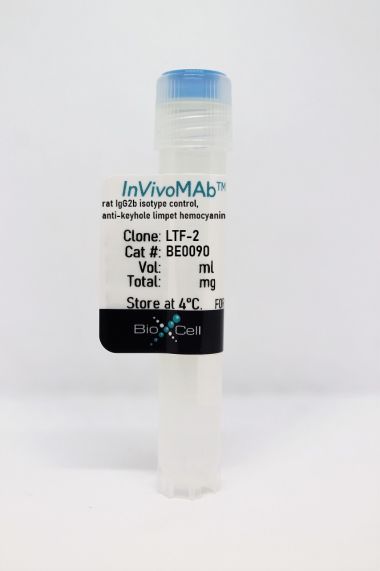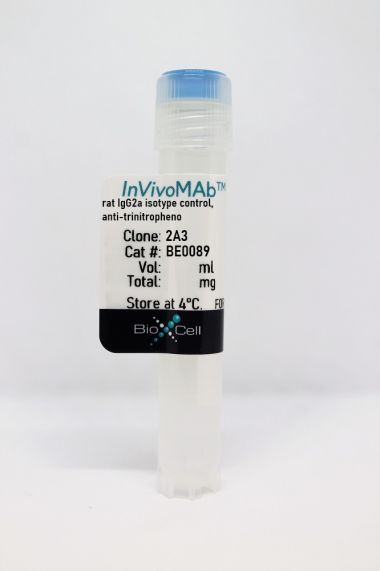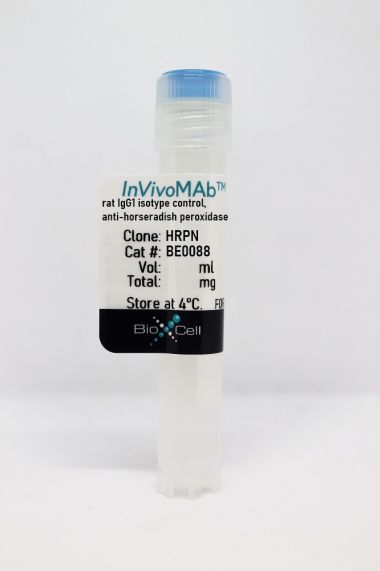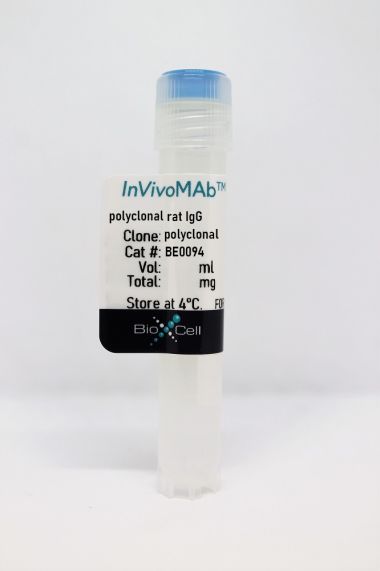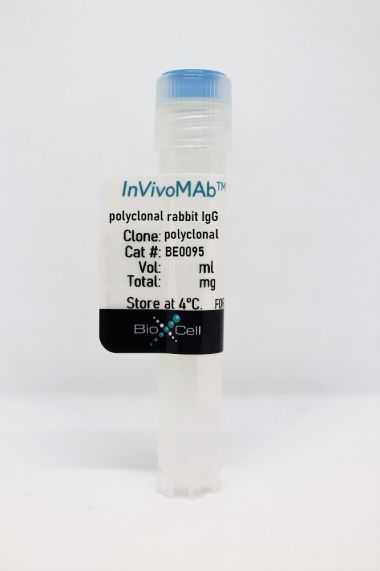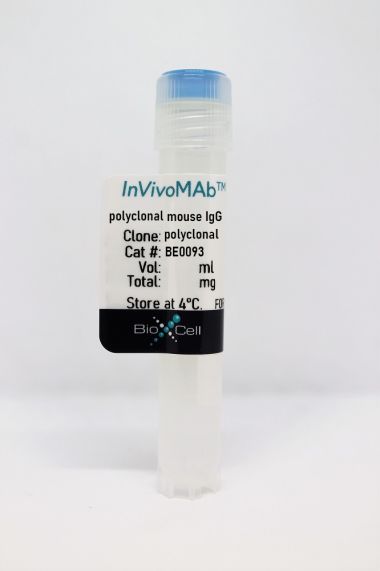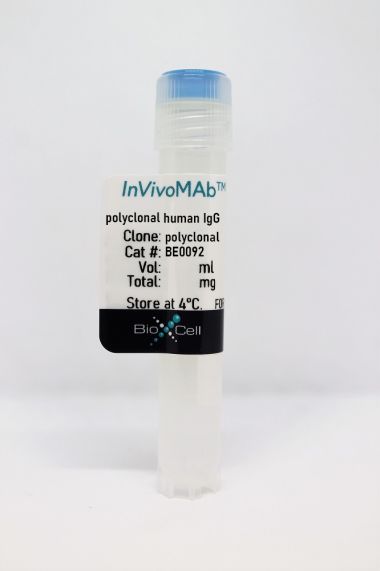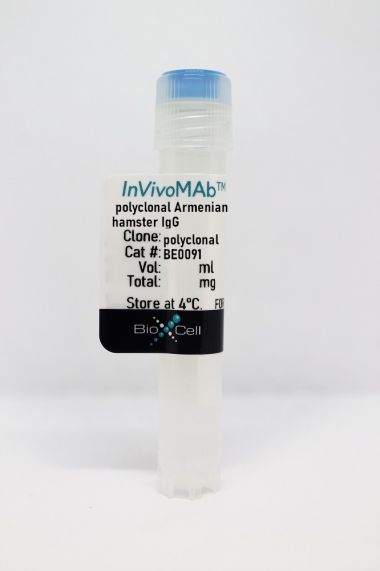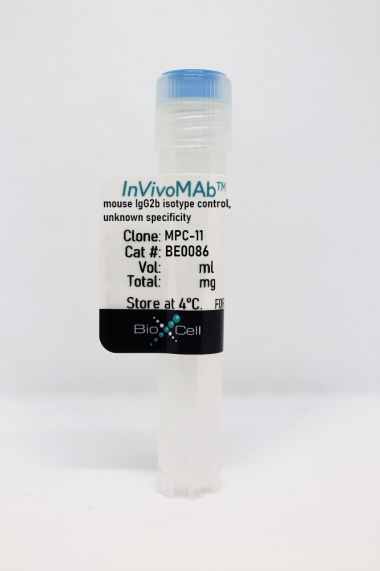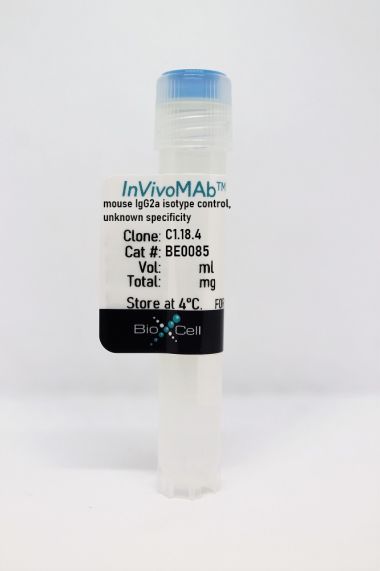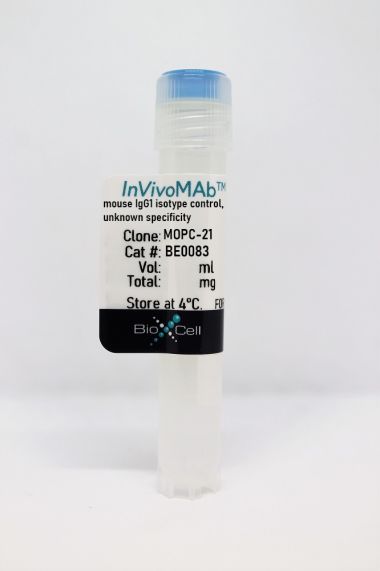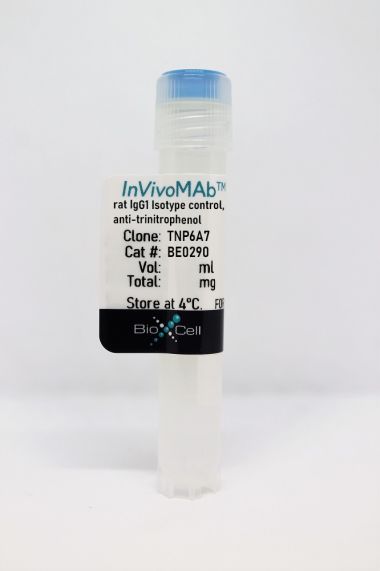InVivoPlus human IgG1 isotype control
Product Details
The human IgG1 isotype control antibody is purified from human myeloma serum and is of unknown specificity. This antibody is suitable for use as a non-targeting isotype control in various in vitro and in vivo studies. It can also be used as a negative control in various diagnostic applications such as ELISA, Western blot, immunofluorescence, immunohistochemistry, immunoprecipitation, and flow cytometry. For research use only.Specifications
| Isotype | Human IgG1, κ |
|---|---|
| Recommended Dilution Buffer | InVivoPure pH 7.0 Dilution Buffer |
| Conjugation | This product is unconjugated. Conjugation is available via our Antibody Conjugation Services. |
| Formulation |
PBS, pH 7.0 Contains no stabilizers or preservatives |
| Endotoxin* |
<1EU/mg (<0.001EU/μg) Determined by LAL gel clotting assay |
| Aggregation* |
<5% Determined by SEC |
| Purity |
>95% Determined by SDS-PAGE |
| Sterility | 0.2 µm filtration |
| Production | Purified from human myeloma serum |
| Purification | Protein A |
| RRID | AB_2687817 |
| Molecular Weight | 150 kDa |
| Murine Pathogen Tests* |
Ectromelia/Mousepox Virus: Negative Hantavirus: Negative K Virus: Negative Lactate Dehydrogenase-Elevating Virus: Negative Lymphocytic Choriomeningitis virus: Negative Mouse Adenovirus: Negative Mouse Cytomegalovirus: Negative Mouse Hepatitis Virus: Negative Mouse Minute Virus: Negative Mouse Norovirus: Negative Mouse Parvovirus: Negative Mouse Rotavirus: Negative Mycoplasma Pulmonis: Negative Pneumonia Virus of Mice: Negative Polyoma Virus: Negative Reovirus Screen: Negative Sendai Virus: Negative Theiler’s Murine Encephalomyelitis: Negative |
| Human Pathogen Test Results |
Hepatitis B Surface Antigen: Negative Human Immunodeficiency Virus 1 antibodies: Negative Human Immunodeficiency Virus 2 antibodies: Negative Hepatitis C Virus antibodies: Negative * These tests cannot guarantee the absence of infective agents |
| Storage | The antibody solution should be stored at the stock concentration at 4°C. Do not freeze. |
Additional Formats
Recommended Products
Li, M., et al. (2019). "Genomic ERBB2/ERBB3 mutations promote PD-L1-mediated immune escape in gallbladder cancer: a whole-exome sequencing analysis" Gut 68(6): 1024-1033. PubMed
OBJECTIVES: Patients with gallbladder carcinoma (GBC) lack effective treatment methods largely due to the inadequacy of both molecular characterisation and potential therapeutic targets. We previously uncovered a spectrum of genomic alterations and identified recurrent mutations in the ErbB pathway in GBC. Here, we aimed to study recurrent mutations of genes and pathways in a larger cohort of patients with GBC and investigate the potential mechanisms and clinical significance of these mutations. DESIGN: We performed whole-exome sequencing (WES) in 157 patients with GBC. Functional experiments were applied in GBC cell lines to explore the oncogenic roles of ERBB2/ERBB3 hotspot mutations, their correlation with PD-L1 expression and the underlying mechanisms. ERBB inhibitors and a PD-L1 blocker were used to evaluate the anticancer activities in co-culture systems in vitro and in vivo. RESULTS: WES identified ERBB2 and ERBB3 mutations at a frequency of 7%-8% in the expanded cohort, and patients with ERBB2/ERBB3 mutations exhibited poorer prognoses. A set of in vitro and in vivo experiments revealed increased proliferation/migration on ERBB2/ERBB3 mutation. Ectopic expression of ERBB2/ERBB3 mutants upregulated PD-L1 expression in GBC cells, effectively suppressed normal T-cell-mediated cytotoxicity in vitro through activation of the PI3K/Akt signalling pathway and contributed to the growth and progression of GBC in vivo. Treatment with an ERBB2/ERBB3 inhibitor or a PD-L1 monoclonal antibody reversed these immunosuppressive effects, and combined therapy revealed promising therapeutic activities. CONCLUSIONS: ERBB2/ERBB3 mutations may serve as useful biomarkers in identifying patients who are sensitive to ERBB2/ERBB3 inhibitors and PD-L1 monoclonal antibody treatment. TRIAL REGISTRATION NUMBER: NCT02442414;Pre-results.
- Cancer Research,
- Endocrinology and Physiology,
- Genetics,
- Immunology and Microbiology
Single-cell RNA sequencing reveals enhanced antitumor immunity after combined application of PD-1 inhibitor and Shenmai injection in non-small cell lung cancer.
In Cell Communication and Signaling : CCS on 10 July 2023 by Yu, D., Yang, P., et al.
PubMed
Immune checkpoint inhibitors (ICIs) have altered the clinical management of non-small cell lung cancer (NSCLC). However, the low response rate, severe immune-related adverse events (irAEs), and hyperprogressive disease following ICIs monotherapy require attention. Combination therapy may overcome these limitations and traditional Chinese medicine with immunomodulatory effects provides a promising approach. Shenmai injection (SMI) is a clinically effective adjuvant treatment for cancer with chemotherapy and radiotherapy. Therefore, the combined effects and mechanisms of SMI and programmed death-1 (PD-1) inhibitor against NSCLC was focused on this study. A Lewis lung carcinoma mouse model and a lung squamous cell carcinoma humanized mouse model were used to investigate the combined efficacy and safety of SMI and PD-1 inhibitor. The synergistic mechanisms of the combination therapy against NSCLC were explored using single-cell RNA sequencing. Validation experiments were performed using immunofluorescence analysis, in vitro experiment, and bulk transcriptomic datasets. In both models, combination therapy alleviated tumor growth and prolonged survival without increasing irAEs. The GZMAhigh and XCL1high natural killer (NK) cell subclusters with cytotoxic and chemokine signatures increased in the combination therapy, while malignant cells from combination therapy were mainly in the apoptotic state, suggesting that mediating tumor cell apoptosis through NK cells is the main synergistic mechanisms of combination therapy. In vitro experiment confirmed that combination therapy increased secretion of Granzyme A by NK cells. Moreover, we discovered that PD-1 inhibitor and SMI combination blocked inhibitory receptors on NK and T cells and restores their antitumoral activity in NSCLC better than PD-1 inhibitor monotherapy, and immune and stromal cells exhibited a decrease of angiogenic features and attenuated cancer metabolism reprogramming in microenvironment of combination therapy. This study demonstrated that SMI reprograms tumor immune microenvironment mainly by inducing NK cells infiltration and synergizes with PD-1 inhibitor against NSCLC, suggested that targeting NK cells may be an important strategy for combining with ICIs. Video Abstract. © 2023. The Author(s).
- Biochemistry and Molecular biology,
- COVID-19
An ACE2 decoy can be administered by inhalation and potently targets omicron variants of SARS-CoV-2.
In EMBO Molecular Medicine on 8 November 2022 by Zhang, L., Narayanan, K. K., et al.
PubMed
Monoclonal antibodies targeting the SARS-CoV-2 spike (S) neutralize infection and are efficacious for the treatment of COVID-19. However, SARS-CoV-2 variants, notably sublineages of B.1.1.529/omicron, have emerged that escape antibodies in clinical use. As an alternative, soluble decoy receptors based on the host entry receptor ACE2 broadly bind and block S from SARS-CoV-2 variants and related betacoronaviruses. The high-affinity and catalytically active decoy sACE22 .v2.4-IgG1 was previously shown to be effective against SARS-CoV-2 variants when administered intravenously. Here, inhalation of aerosolized sACE22 .v2.4-IgG1 increased survival and ameliorated lung injury in K18-hACE2 mice inoculated with P.1/gamma virus. Loss of catalytic activity reduced the decoy's therapeutic efficacy, which was further confirmed by intravenous administration, supporting dual mechanisms of action: direct blocking of S and turnover of ACE2 substrates associated with lung injury and inflammation. Furthermore, sACE22 .v2.4-IgG1 tightly binds and neutralizes BA.1, BA.2, and BA.4/BA.5 omicron and protects K18-hACE2 mice inoculated with a high dose of BA.1 omicron virus. Overall, the therapeutic potential of sACE22 .v2.4-IgG1 is demonstrated by the inhalation route and broad neutralization potency persists against highly divergent SARS-CoV-2 variants. © 2022 The Authors. Published under the terms of the CC BY 4.0 license.
- Cardiovascular biology
Comparative efficacy and mechanism of action of cardiac progenitor cells after cardiac injury.
In IScience on 19 August 2022 by Gunasekaran, M., Mishra, R., et al.
PubMed
Successful cell therapy requires cells to resist the hostile ischemic myocardium, be retained to continue secreting cardioprotective growth factors/exosomes, and resist immunological host responses. Clinically relevant stem/progenitor cells in a rodent model of acute myocardial infarction (MI) demonstrated that neonatal cardiac mesenchymal stromal cells (nMSCs) provide the most robust cardiac functional recovery. Transplanted nMSCs significantly increased the number of tissue reparative macrophages and regulatory T-cells and decreased monocyte-derived inflammatory macrophages and neutrophils in the host myocardium. mRNA microarray and single-cell analyses combined with targeted depletion studies established CD47 in nMSCs as a key molecule responsible for cell retention in the myocardium through an antiphagocytic mechanism regulated by miR34a-5p. Gain and loss-of-function studies demonstrated that miR34a-5p also regulated the production of exosomes and cardioprotective paracrine factors in the nMSC secretome. In conclusion, miR34a-5p and CD47 play an important role in determining the composition of nMSCs' secretome and immune evasion, respectively.© 2022.
- FC/FACS,
- Cancer Research,
- Immunology and Microbiology
Expression of the mono-ADP-ribosyltransferase ART1 by tumor cells mediates immune resistance in non-small cell lung cancer.
In Science Translational Medicine on 16 March 2022 by Wennerberg, E., Mukherjee, S., et al.
PubMed
Most patients with non-small cell lung cancer (NSCLC) do not achieve durable clinical responses from immune checkpoint inhibitors, suggesting the existence of additional resistance mechanisms. Nicotinamide adenine dinucleotide (NAD)-induced cell death (NICD) of P2X7 receptor (P2X7R)-expressing T cells regulates immune homeostasis in inflamed tissues. This process is mediated by mono-adenosine 5'-diphosphate (ADP)-ribosyltransferases (ARTs). We found an association between membranous expression of ART1 on tumor cells and reduced CD8 T cell infiltration. Specifically, we observed a reduction in the P2X7R+ CD8 T cell subset in human lung adenocarcinomas. In vitro, P2X7R+ CD8 T cells were susceptible to ART1-mediated ADP-ribosylation and NICD, which was exacerbated upon blockade of the NAD+-degrading ADP-ribosyl cyclase CD38. Last, in murine NSCLC and melanoma models, we demonstrate that genetic and antibody-mediated ART1 inhibition slowed tumor growth in a CD8 T cell-dependent manner. This was associated with increased infiltration of activated P2X7R+CD8 T cells into tumors. In conclusion, we describe ART1-mediated NICD as a mechanism of immune resistance in NSCLC and provide preclinical evidence that antibody-mediated targeting of ART1 can improve tumor control, supporting pursuit of this approach in clinical studies.
- Cancer Research,
- Immunology and Microbiology
B7-H3×4-1BB bispecific antibody augments antitumor immunity by enhancing terminally differentiated CD8+ tumor-infiltrating lymphocytes.
In Science Advances on 1 January 2021 by You, G., Lee, Y., et al.
PubMed
Cancer immunotherapy with 4-1BB agonists has limited further clinical development because of dose-limiting toxicity. Here, we developed a bispecific antibody (bsAb; B7-H3×4-1BB), targeting human B7-H3 (hB7-H3) and mouse or human 4-1BB, to restrict the 4-1BB stimulation in tumors. B7-H3×m4-1BB elicited a 4-1BB-dependent antitumor response in hB7-H3-overexpressing tumor models without systemic toxicity. BsAb primarily targets CD8 T cells in the tumor and increases their proliferation and cytokine production. Among the CD8 T cell population in the tumor, 4-1BB is solely expressed on PD-1+Tim-3+ "terminally differentiated" subset, and bsAb potentiates these cells for eliminating the tumor. Furthermore, the combination of bsAb and PD-1 blockade synergistically inhibits tumor growth accompanied by further increasing terminally differentiated CD8 T cells. B7-H3×h4-1BB also shows antitumor activity in h4-1BB-expressing mice. Our data suggest that B7-H3×4-1BB is an effective and safe therapeutic agent against B7-H3-positive cancers as monotherapy and combination therapy with PD-1 blockade. Copyright © 2021 The Authors, some rights reserved; exclusive licensee American Association for the Advancement of Science. No claim to original U.S. Government Works. Distributed under a Creative Commons Attribution NonCommercial License 4.0 (CC BY-NC).
- Immunology and Microbiology,
- Neuroscience
Pre-clinical characterisation of E2814, a high-affinity antibody targeting the microtubule-binding repeat domain of tau for passive immunotherapy in Alzheimer's disease.
In Acta Neuropathologica Communications on 4 February 2020 by Roberts, M., Sevastou, I., et al.
PubMed
Tau deposition in the brain is a pathological hallmark of many neurodegenerative disorders, including Alzheimer's disease (AD). During the course of these tauopathies, tau spreads throughout the brain via synaptically-connected pathways. Such propagation of pathology is thought to be mediated by tau species ("seeds") containing the microtubule binding region (MTBR) composed of either three repeat (3R) or four repeat (4R) isoforms. The tau MTBR also forms the core of the neuropathological filaments identified in AD brain and other tauopathies. Multiple approaches are being taken to limit tau pathology, including immunotherapy with anti-tau antibodies. Given its key structural role within fibrils, specifically targetting the MTBR with a therapeutic antibody to inhibit tau seeding and aggregation may be a promising strategy to provide disease-modifying treatment for AD and other tauopathies. Therefore, a monoclonal antibody generating campaign was initiated with focus on the MTBR. Herein we describe the pre-clinical generation and characterisation of E2814, a humanised, high affinity, IgG1 antibody recognising the tau MTBR. E2814 and its murine precursor, 7G6, as revealed by epitope mapping, are antibodies bi-epitopic for 4R and mono-epitopic for 3R tau isoforms because they bind to sequence motif HVPGG. Functionally, both antibodies inhibited tau aggregation in vitro. They also immunodepleted a variety of MTBR-containing tau protein species. In an in vivo model of tau seeding and transmission, attenuation of deposition of sarkosyl-insoluble tau in brain could also be observed in response to antibody treatment. In AD brain, E2814 bound different types of tau filaments as shown by immunogold labelling and recognised pathological tau structures by immunohistochemical staining. Tau fragments containing HVPGG epitopes were also found to be elevated in AD brain compared to PSP or control. Taken together, the data reported here have led to E2814 being proposed for clinical development.

